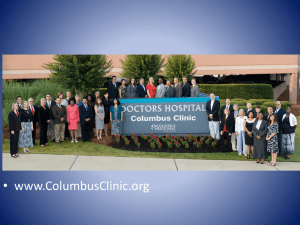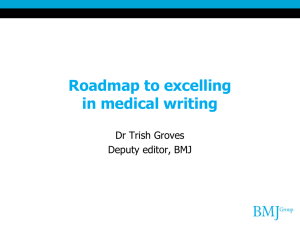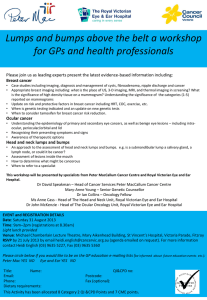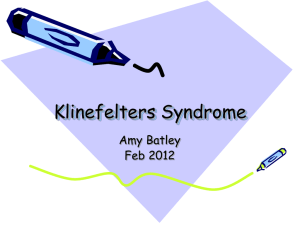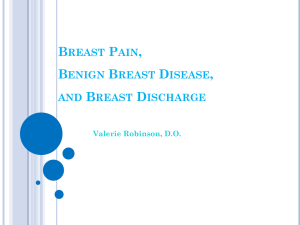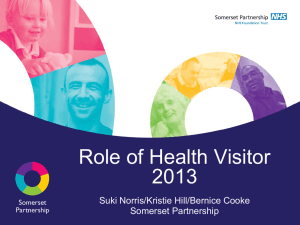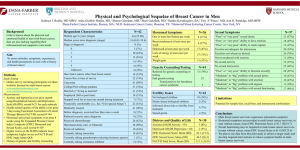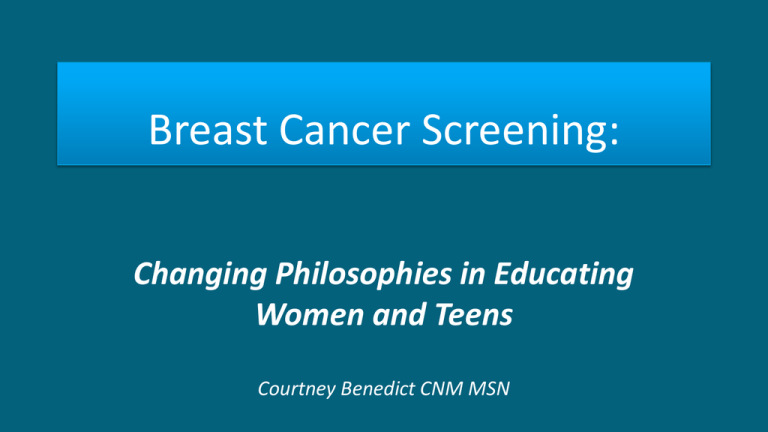
Breast Cancer Screening:
Changing Philosophies in Educating
Women and Teens
Courtney Benedict CNM MSN
Disclosures
Merck Nexplanon trainer
Session Objectives
• Explain the rationale for initiation and
frequency of clinical breast exams to clients
• Compare screening mammogram
recommendations from USPSTF and ACOG
• Develop a script to discuss breast self
awareness with clients
• Detect health history components that place a
client at increased risk for breast cancer
Percent of New Cases by Age Group: Breast Cancer
SEER 18 2007-2011, All Races, Females
Percent of Deaths by Age Group: Breast Cancer
EER 18 2007-2011, All Races, Females
Breast Cancer Risk Factors
●
●
●
●
BRCA1 or BRCA2 gene mutation
Family history of breast cancer
Therapeutic radiation to the chest <30yo
Atypical ductal or lobular hyperplasia or
lobular carcinoma in situ on previous biopsy
Breast Cancer Risk Factors
●
●
●
●
●
●
●
●
Late parity (>30yo) or nulliparity
Early menarche (<12) or late menopause (>55)
Combined hormonal replacement therapy > 10 yrs use
Postmenopausal obesity
Alcohol consumption ( 2 drinks per dy or more)
Smoking before first live birth
Sedentary lifestyle
White race
Simplified Risk Screening Questions
A. Have you had breast or ovarian cancer?
B. Has a blood relative had breast or ovarian cancer?
1. If answer to both questions are No, recommend
average risk screening
2. If answer to Q.A is yes, ask f/u questions 2.A.
3. If answer to Q.B is yes, ask f/u questions 2.B.
CLINICAL BREAST EXAM
PROFESSIONAL ORGANIZATION
RECOMMENDATION
USPSTF
“I” - current evidence insufficient to assess
benefits and harms
ACOG
Q1-3 yrs 20-39yo, then Q yr >40yo
ACS
Q 3yr 20-39yo
QFP
Lists all of the above
MAMMOGRAPHY
PROFESSIONAL ORGANIZATION
RECOMMENDATION
USPSTF
50-74 biennial, <50 on individual basis
taking patient context into account
ACOG
Offer annually 50-74 yo
Offer annually 40-49
ACS
Annual 40 yo and continue as long as in
good health
QFP
“Follow USPSTF”: 50-74yo biennial, <50 if
other conditions support
BREAST SELF-EXAMINATION
PROFESSIONAL ORGANIZATION
RECOMMENDATION
USPSTF
“D” - recommends against teaching BSE
ACOG
BSA 20 yo and older
ACS
BSE optional starting in 20’s
QFP
“USPSTF recommends against teaching
breast self-examination”
SUMMARY OF QFP SCREENING
RECOMMENDATIONS
• Clinical breast exams can be performed based
on ACOG recommendation (q1-3 yrs 20-39yo,
then annually >40yo)
• Mammogram biennially 50-74yo,<50 if other
conditions support doing so
• Do not teach breast self-examination
• Refer for genetic counseling if risk is increased
ASSESS RISK
DISCUSS OPTIONS
EDUCATE & VERIFY
UNDERSTANDING
FORMULATE PLAN
SHARED DECISION MAKING
•
•
•
•
Inform patient about issue needing decision
Invite patient participation in the process
Present benefits and harms
Help patients achieve decisions
AVERAGE RISK CLIENT
CLIENT EDUCATION on CBE
“We don’t have clear evidence that doing CBE
actually helps to detect breast cancer. If you
ever have any symptoms in your breasts that
you are worried about.. I am happy to
examine your breasts. I will examine your
breast every 1-3 years if you would like. ”
CLINICAL BREAST EXAM
BENEFITS
• Potential to find a
mass or other
symptom that
results in cancer
detection
HARMS
• False Positives (and
subsequent
additional imaging,
biopsies, anxiety)
• False Negatives (and
failure to diagnosis
cancer)
CLIENT EDUCATION on
MAMMOGRAPHY
AVERAGE RISK CLIENT
• You are at average risk for breast cancer
• It is recommended that you have a
mammogram every 2 yrs between 50-74yo
• The decision to have a mammogram before 50
is yours
• You should make this decision based on
looking at the benefits and harms of
mammograms
MAMMOGRAPHY
BENEFITS
• Potential detection
of breast cancer
•
•
•
•
•
HARMS
Radiation Exposure
Pain
Anxiety, Distress
False Positives
Overdiagnosis
CLIENT EDUCATION on
BREAST SELF-EXAM
AVERAGE RISK CLIENT
• Breast self-exam is not likely to find cancer
• You do not need to check your breasts every
month
• Know what your normal anatomy feels like
• See a clinician if you have any concerns
BREAST SELF EXAMINATION
BENEFITS
• Awareness of breast
anatomy
• Potential to find a
mass or other
symptom that
results in cancer
detection
HARMS
• False Positives (and
subsequent
additional imaging,
biopsies, anxiety)
• False Negatives (and
failure to diagnosis
cancer)
What Is Breast Self Awareness?
• Women understanding the normal feel and
texture of their breasts
• No specific interval or technique
• Goal is to be alert to changes
• ACOG recommends educating on BSA for
women 20 and older
CLIENT EDUCATION on RISK
REDUCTION
•
•
•
•
•
Limit alcohol consumption
Don’t smoke tobacco
Maintain ideal BMI
Exercise regularly
Limit dosing and total time on hormone
therapy



